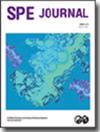核磁共振测井多等待时间和多回波时间活化数据联合反演法与流体识别
IF 3.2
3区 工程技术
Q1 ENGINEERING, PETROLEUM
引用次数: 0
摘要
核磁共振(NMR)测井对储层评价非常有效;目前,NMR 测井数据采集参数主要分为双等待时间(TW)和双回波时间(TE),然后分别进行分析。然而,两种激活方式的解释结果往往不一致,混淆了储层流体的识别和定量评价。根据核磁共振测井的多 TW 和 -TE 激活原理,分析了弛豫机理,建立了不同激活的回波列振幅与孔隙结构、流体类型和含量之间的关系。构建了多活度回波序列振幅的联合系统。然后,通过最小二乘法(LSQR)计算出冲刷区的差谱和油孔率。设定流体饱和岩石模型,利用核磁共振数值模拟验证数据联合反演的正确性,计算结果比之前的时域分析(TDA)处理方法更加精确。此外,还构建了冲洗带-深部感应电阻率交叉图的油层孔隙度,并提出了流体识别方法。上述方法应用于鄂尔多斯盆地西部的延长地层。与传统方法相比,该方法基于对研究区域核磁共振多TW和-TE测井数据的联合反演,能更精确地计算流体体积和饱和度。根据这些计算得出的交叉图显示,该方法在识别流体类型方面具有很高的效率;因此,该流体识别方法具有实际应用的潜力,并具有在现场广泛采用的相当大的价值。本文章由计算机程序翻译,如有差异,请以英文原文为准。
Joint Inversion Method of Nuclear Magnetic Resonance Logging Multiwait Time and Multiecho Time Activation Data and Fluid Identification
Nuclear magnetic resonance (NMR) logging is effective for reservoir evaluation; at present, NMR logging data acquisition parameters are primarily divided into dual wait time (TW) and dual echo time (TE) and then are analyzed, respectively. However, the interpretation results of the two activations are often inconsistent and confuse the identification and quantitative evaluation of reservoir fluids. Based on the principle of multi-TW and -TE activations of NMR logging, the relaxation mechanism is analyzed, and the relationship between the amplitude of the echo train and the pore structure, fluid types, and content of different activations is established. The joint system of the amplitude of echo trains in multiactivations is constructed. Then, the difference spectrum and the oil porosity of the flushed zone can be calculated by the least squares algorithm (LSQR). The fluid-saturated rock model is set, and the numerical simulation of NMR is used to verify the data joint inversion is correct and that the calculation result is more accurate than the previous time domain analysis (TDA) processing method. Moreover, the oil porosity of the flushed zone-deep induction resistivity crossplot is constructed and is also proposed to identify fluid. The above method was applied to the Yanchang Formation in the western Ordos Basin. Based on the joint inversion of NMR multi-TW and -TE logging data in the study area, the methodology yields more precise calculations of fluid volume and saturation compared with conventional approaches. The crossplots derived from these calculations demonstrate high efficacy in identifying fluid types; therefore, the method for fluid identification exhibits potential for practical application and holds considerable value for widespread adoption in the field.
求助全文
通过发布文献求助,成功后即可免费获取论文全文。
去求助
来源期刊

SPE Journal
工程技术-工程:石油
CiteScore
7.20
自引率
11.10%
发文量
229
审稿时长
4.5 months
期刊介绍:
Covers theories and emerging concepts spanning all aspects of engineering for oil and gas exploration and production, including reservoir characterization, multiphase flow, drilling dynamics, well architecture, gas well deliverability, numerical simulation, enhanced oil recovery, CO2 sequestration, and benchmarking and performance indicators.
 求助内容:
求助内容: 应助结果提醒方式:
应助结果提醒方式:


